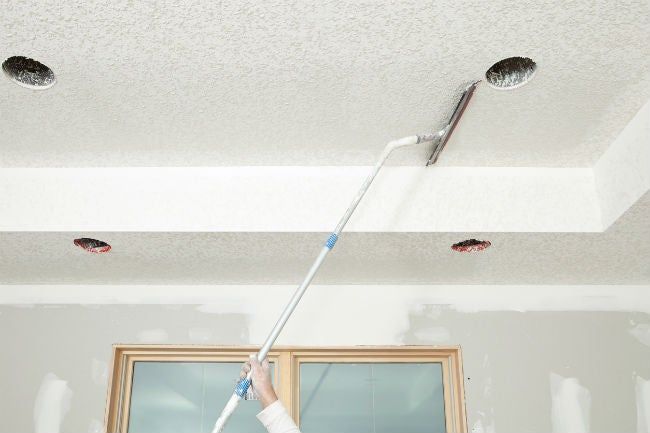Page Contents
Quick Answers
Knockdown ceilings require a specific type of paint called “knockdown texture paint” or “knockdown paint”. This paint contains coarse particles that help create the rough, bumpy texture of a knockdown finish. Regular wall paints are too smooth for a knockdown effect.
What is a Knockdown Ceiling?
A knockdown ceiling, sometimes called a popcorn ceiling, has an irregular, bumpy texture. It is created by applying a thick coat of knockdown texture paint to the ceiling and then “knocking down” the texture using a trowel or drywall knife to flatten any high points. This leaves behind bumps and valleys that make up the knockdown look.
Knockdown ceilings became popular in homes in the 1970s and 80s. The rough texture helps hide any imperfections or flaws in the drywall underneath. It also creates an informal, rustic appearance.
Choosing the Right Knockdown Paint
The key to getting the proper knockdown finish is using a paint formulated specifically for this purpose. Knockdown paint contains aggregates – small particles of sand, perlite, or vermiculite – that provide the coarse texture.
There are a few options for knockdown paint:
– Pre-mixed knockdown paint – This comes premixed and ready to apply. It is the easiest option but provides the least amount of customization.
– Knockdown paint mix – This is a liquid paint base you mix with an aggregate additive. It allows you to control the texture size and look.
– Dry knockdown textures – These are bagged mix products that you mix with water before applying. Again, this allows full customization of the finish.
The pre-mixed options are a good choice for DIYers. The mix and dry options are used more by professional painters and let you match the existing texture.
Texture Size
Knockdown paints and textures come in different aggregate sizes. This affects the final look:
– Fine texture – Very small aggregate, creates a very light orange peel look
– Medium texture – More noticeable knockdown look, moderately bumpy
– Coarse texture – Very heavy aggregate, extremely bumpy finish
Medium texture is the most common for knockdown ceilings. But you can match the existing ceiling or create your own desired finish.
Applying Knockdown Paint
Applying knockdown texture takes some practice to master. Here is a basic overview:
1. Start with a smooth, drywall ceiling that has been primed
2. Use a hopper gun or ceiling texture sprayer to apply a heavy coat of knockdown paint. Apply slightly thicker than the final texture needed.
3. Let the texture sit for a few minutes until tacky.
4. Use a wide drywall knife or trowel to flatten any high points in the texture by dragging across the surface. This “knocks down” the texture to the desired look.
5. A second coat can be applied and knocked down to increase the texture.
6. When paint is fully dry, the ceiling can be painted. Usually a flat or matte paint is used to complement the texture.
It takes some experimenting to find the right consistency and technique. Test panels are recommended to dial in the process before doing the entire ceiling. Allow the texture coats to fully dry before painting.
Pro Tips for Knockdown Ceilings
Here are some additional tips for getting great results with knockdown ceilings:
– Wear a protective mask – Knockdown products contain silica sand which can be harmful if inhaled.
– Use heavy drop cloths – The texture spray is messy. Cover all floors, walls, and furniture thoroughly.
– Use low pressure – High pressure sprayers can destroy the texture. Use just enough pressure to atomize the paint.
– Get the consistency right – Thick paint or texture won’t spray evenly. Add water sparingly until reaching a good viscosity.
– Keep a wet edge – Maintain a wet edge as you spray and overlap passes slightly to avoid lap marks once dry.
– Make feathered edges – When overlapping with a second coat, feather out the new application so the transition is invisible.
– Knock down evenly – Use smooth, consistent motions to avoid dips or lines in the finish.
– Apply base coats first – Prime and paint the ceiling before adding knockdown texture for best results.
Hiring a Professional
While a DIY knockdown finish is possible, it’s challenging to master the technique. Imperfections like lap marks, uneven textures, and drips are common problems.
Hiring a professional contractor who specializes in knockdown ceilings often yields better results. They have the right tools, experience, and skills to apply the texture quickly and flawlessly. This option does come with a higher cost but saves the hassle and potential frustration of DIY.
Conclusion
Achieving the bumpy, irregular look of a knockdown ceiling requires using a special type of paint. Knockdown, popcorn, or texture paint contains coarse aggregate additives that make it thick and chunky for texture. Pre-mixed and dry bag options are available to suit different needs. With some skill and practice in the application techniques, a homeowner can tackle a knockdown ceiling DIY. For best results, consider hiring a pro painter familiar with this specialty finish. Their expertise can save time and trouble while creating a flawless knockdown ceiling.
